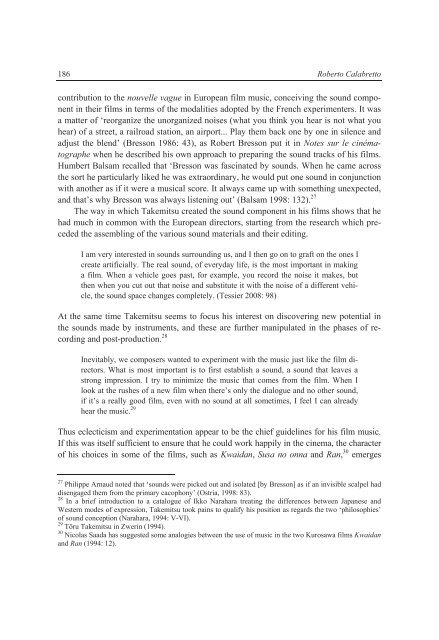Musica che affronta il silenzio - Scritti su Toru Takemitsu - Pavia ...
Musica che affronta il silenzio - Scritti su Toru Takemitsu - Pavia ...
Musica che affronta il silenzio - Scritti su Toru Takemitsu - Pavia ...
You also want an ePaper? Increase the reach of your titles
YUMPU automatically turns print PDFs into web optimized ePapers that Google loves.
186<br />
Roberto Calabretto<br />
contribution to the nouvelle vague in European f<strong>il</strong>m music, conceiving the sound component<br />
in their f<strong>il</strong>ms in terms of the modalities adopted by the French experimenters. It was<br />
a matter of ‘reorganize the unorganized noises (what you think you hear is not what you<br />
hear) of a street, a ra<strong>il</strong>road station, an airport... Play them back one by one in s<strong>il</strong>ence and<br />
adjust the blend’ (Bresson 1986: 43), as Robert Bresson put it in Notes <strong>su</strong>r le cinématographe<br />
when he described his own approach to preparing the sound tracks of his f<strong>il</strong>ms.<br />
Humbert Balsam recalled that ‘Bresson was fascinated by sounds. When he came across<br />
the sort he particularly liked he was extraordinary, he would put one sound in conjunction<br />
with another as if it were a musical score. It always came up with something unexpected,<br />
and that’s why Bresson was always listening out’ (Balsam 1998: 132). 27<br />
The way in which Takemit<strong>su</strong> created the sound component in his f<strong>il</strong>ms shows that he<br />
had much in common with the European directors, starting from the research which preceded<br />
the assembling of the various sound materials and their editing.<br />
I am very interested in sounds <strong>su</strong>rrounding us, and I then go on to graft on the ones I<br />
create artificially. The real sound, of everyday life, is the most important in making<br />
a f<strong>il</strong>m. When a vehicle goes past, for example, you record the noise it makes, but<br />
then when you cut out that noise and <strong>su</strong>bstitute it with the noise of a different vehicle,<br />
the sound space changes completely. (Tessier 2008: 98)<br />
At the same time Takemit<strong>su</strong> seems to focus his interest on discovering new potential in<br />
the sounds made by instruments, and these are further manipulated in the phases of recording<br />
and post-production. 28<br />
Inevitably, we composers wanted to experiment with the music just like the f<strong>il</strong>m directors.<br />
What is most important is to first establish a sound, a sound that leaves a<br />
strong impression. I try to minimize the music that comes from the f<strong>il</strong>m. When I<br />
look at the rushes of a new f<strong>il</strong>m when there’s only the dialogue and no other sound,<br />
if it’s a really good f<strong>il</strong>m, even with no sound at all sometimes, I feel I can already<br />
hear the music. 29<br />
Thus eclecticism and experimentation appear to be the chief guidelines for his f<strong>il</strong>m music.<br />
If this was itself <strong>su</strong>fficient to en<strong>su</strong>re that he could work happ<strong>il</strong>y in the cinema, the character<br />
of his choices in some of the f<strong>il</strong>ms, <strong>su</strong>ch as Kwaidan, Susa no onna and Ran, 30 emerges<br />
27<br />
Ph<strong>il</strong>ippe Arnaud noted that ‘sounds were picked out and isolated [by Bresson] as if an invisible scalpel had<br />
disengaged them from the primary cacophony’ (Ostria, 1998: 83).<br />
28<br />
In a brief introduction to a catalogue of Ikko Narahara treating the differences between Japanese and<br />
Western modes of expression, Takemit<strong>su</strong> took pains to qualify his position as regards the two ‘ph<strong>il</strong>osophies’<br />
of sound conception (Narahara, 1994: V-VI).<br />
29<br />
Tru Takemit<strong>su</strong> in Zwerin (1994).<br />
30<br />
Nicolas Saada has <strong>su</strong>ggested some analogies between the use of music in the two Kurosawa f<strong>il</strong>ms Kwaidan<br />
and Ran (1994: 12).

















